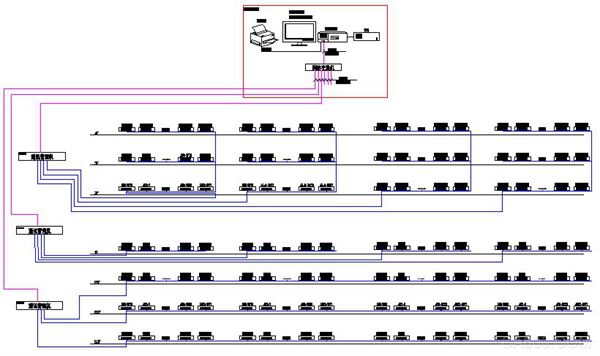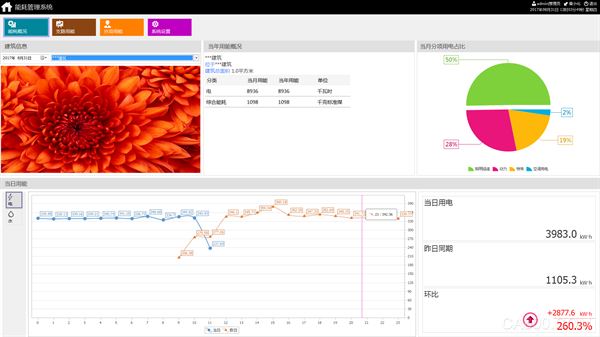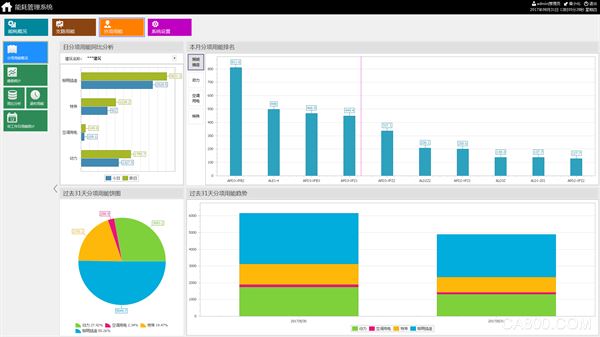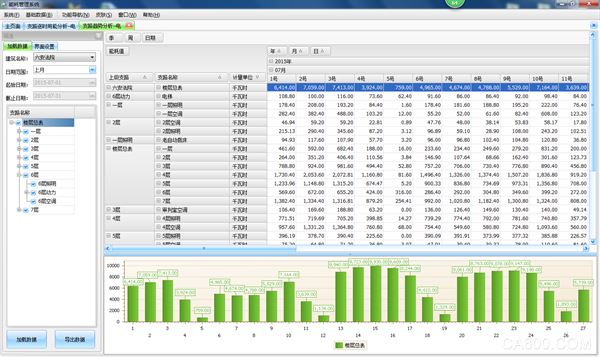0 Preface
With the development of society, the consumption of energy is also growing rapidly. Especially the growth of building energy consumption has been particularly rapid. It has become the third largest energy consumption in addition to industry and transportation. According to the current development trend of the construction industry, the energy output of the society will not be able to meet the energy demand after several years, so reducing the consumption of energy is a very important issue that needs to be solved as soon as possible. In the building energy consumption, the energy consumption of large-scale public buildings occupies a large share. Although the total energy consumption is far less than the consumption of residential buildings, the consumption of energy consumption per unit area is very large, so the large-scale public buildings Energy-saving work has great potential. The construction of a large-scale public building energy monitoring system enables people to fully understand the energy consumption of large-scale public buildings, and lays a foundation for the formulation of effective energy-saving and emission-reduction policies and decisions. With the advancement of China’s urbanization process and economic development, China’s The total amount of energy consumed by buildings shows a trend of continuous growth, and the growth rate is getting faster and faster. If the building energy consumption is allowed to increase at this rate, it will inevitably bring great pressure on China's energy supply security. Therefore, building energy conservation is imperative.
Taking the swimming and diving hall of Huanglong Sports Center in Zhejiang Province as an example, this paper introduced the application of the energy consumption online monitoring system in large-scale co-construction through the data transmission network construction, data collection and analysis of the energy consumption online monitoring system.
1. Project Overview and Construction Objectives
Huanglong Sports Center Diving Hall The new construction project is located at No. 1 Huanglong Road, Xihu District, Hangzhou. The main functions are the garage and equipment room, and the aboveground part. The main function is diving competition. This building is a Class II high-rise building.
The entire building adopts two independent 10KV high-voltage incoming lines and is supplied by the basement 10/0.4KV substation. The working voltage of the power supply is three-phase five-wire 380/220V. 10/0.4KV substations are set up in the basement of this project, and sub-item measurement is carried out on the floor distribution boxes. There are 48 measuring nodes, including lighting, sockets, and air conditioners. The specific construction goals are as follows:
(1) Achieve sub-item measurement of energy consumption data;
(2) Part of the area to implement household monitoring, measurement and centralized management;
(3) Clearly describe the current status of energy use, identify problems in energy management, and provide direction for energy management improvement;
(4) To enable the energy management department to effectively monitor and manage the energy system;
(5) Provide reference data for research, design and construction of energy conservation and consumption reduction.
Comprehensive energy consumption: automatic, real-time, on-line data acquisition, transmission, and storage of the electrical resources of the diving hall.
Classification and measurement: According to the user's energy composition, statistics of each energy consumption will be managed in an integrated manner.
Sub-item measurement: The power consumption should be subdivided and measured according to the type of electricity: lighting and socket power, air-conditioning power, power power, and other special power.
2. Design of energy consumption online monitoring system
The design of the entire energy consumption online monitoring system is based on the "Guidelines for the Distinct Energy Consumption Data Transmission Technology for Energy Monitoring Systems of State Offices and Offices and Large Public Buildings," and the "Measurement of Electricity Consumption for State Offices and Large Public Buildings in Zhejiang Province." Based on related technical guidelines such as System Design Standards, an on-line energy consumption monitoring system that meets the actual needs of users is built. The entire system completes the installation of energy consumption meters and energy-consumption data acquisition devices for the building to achieve energy consumption data collected from the building. , Remote transmission of data, data statistics and display capabilities. The entire system includes the original collection of energy consumption data, on-line transmission of energy consumption data, on-line analysis and diagnosis of energy consumption data, and so on. Through the installation of energy metering devices, the original collection of energy consumption data is achieved; through the installation of communication management machines, The online transmission of energy consumption data; through the collection of energy consumption data, the formation of visual trends, determine the higher energy consumption range of diagnosis to form high consumption causes; through the later configuration of energy-saving energy-saving products to improve the operation and management mode, to save energy and reduce consumption; Comparison of data before and after energy saving and consumption reduction to see the effects of energy saving and consumption reduction.
2.1 Raw Energy Consumption Data Collection
The original collection of energy consumption data is the basis of the entire energy consumption online monitoring system, and is the basic constituent element of the entire energy consumption online monitoring system. It refers to the division of major energy types consumed by office buildings of government agencies and large-scale public buildings, and the energy consumption of buildings should be Including power consumption, water consumption, air consumption, central heating heat consumption, central cooling and cooling consumption and other energy consumption, and sub-item energy consumption data refer to one or more types of subdivision in classified energy consumption data. For several items. For example, electrical energy can be divided into four categories, electrical outlet lighting, air conditioning, special electricity and power, and each sub-item can be divided into several sub-items. The power supply for the socket lighting includes lighting in the main working area of ​​the building and power consumption for general equipment. Can be subdivided into socket lighting power, emergency lighting and corridor power, outdoor lighting power three sub-items. Air-conditioning power mainly refers to the energy consumed for cooling and heating in the interior of a building. It also includes two sub-items, the use of cooling and heating stations and the use of air-conditioning terminals. Power use is the power used to provide power services within the building, including three sub-items: elevator power, water pump power, and fan power. These classification items should be calculated and stored within the collector, and the data center should be established to send data to the original data. In this building, the energy consumption information involved mainly includes the power consumption. According to the design requirements of the classification and sub-item measurement system, the electricity metering in this building adopts a multi-function electricity meter, lighting distribution boxes and air-conditioning units on each floor. Electric meters, power distribution boxes and other special power distribution boxes installed multi-function power meter, to achieve the energy of the sub-item acquisition.
The multi-function electricity meter adopts AC sampling technology and can measure the current, voltage, power, power factor and electric energy of the grid separately. The magnification can be set through the membrane switch of the panel. With RS-485 communication interface, using Modbus-RTU communication protocol, all multi-function meter active power metering accuracy of 0.5,
2.2 Data Transmission

Data transmission means that the original classification item data is uploaded to the data center from a distributed building group via a data collector via a remote communication method such as Internet or GPRS, and the data is processed to complete the process of storing the original data. . In this process, the data collector accumulates the data collected at regular intervals to form a data packet in an extensible markup language (XML) format. The data packet includes not only the data to be uploaded but also the corresponding building information and collector information, etc. . The collector also encrypts the data packets to be transmitted, generally using 128-bit aes encryption to ensure data security and upload work. The data transmission network of the entire system includes the 485 network between the on-site measurement acquisition device and the collector and the Ethernet between the collector and the data center. The measurement and collection device and the collector are connected via the RS-485 bus to achieve measurement and acquisition. With the hand-in-hand connection installed, the number of 485 bus connection measuring and collecting devices is connected to the collector. The number of measuring and collecting devices is about 20; the remote data transmission between the collector and the data center is realized through the intelligent network inside the building. The network structure of the system is shown in the figure below:
2.3 software function design of energy consumption online monitoring system
1) Energy consumption online monitoring data processing
Data validation
General verification method for measuring data collected by the metering device: Verification is based on the maximum and minimum values ​​of the measuring device's measuring range. Any reading less than the minimum value or greater than the maximum value belongs to invalid data.
Meter active energy verification method: in addition to the need for general verification, but also for the second verification, the method is: two consecutive data acquisition and reading data increment and time difference to calculate the power, determine the power can not be greater than the branch of energy-consuming equipment 2 times the maximum power.
Itemized energy consumption data calculation
Each sub-item increment of energy consumption shall be calculated mathematically according to the increment of the original data of each metering device. At the same time, sub-item energy consumption daily data shall be calculated. The daily sub-item energy consumption data shall be the energy consumption of a sub-item within one day. The maximum value, minimum value, and average value of the increment and the current day's collection interval; according to the daily energy of the sub-item energy consumption, the monthly and yearly energy consumption data and their maximum, minimum, and average values ​​are calculated. value.
When the full-scale jump of the active energy of the meter occurs, the maximum output number of the meter must be added to the number of acquisitions to ensure the correctness of the calculation processing result.
2) Energy consumption online monitoring management software architecture
The energy consumption online monitoring system adopts a distributed network structure of C/S (client/server) architecture. The system adopts a standardized, networked, and functionally distributed architecture, and has high reliability and easy maintenance. The system is equipped with software and hardware expansion capabilities to support the expansion of system architecture and the upgrade of functions. According to the scale and special needs of the system, it can fully optimize the resources of each node of the network and balance the burden of the network, and facilitate the phased implementation of the system.
3) Energy consumption online monitoring management software system composition
The entire management system consists of four parts: OPC data acquisition terminal, data split storage terminal, data monitoring terminal, data analysis and display terminal. The functions of each part are as follows:
OPC data acquisition terminal
Through the international common OPC interface, the collection terminal stores the current value of all parameters in the smart meter every 15 minutes to the database for later energy consumption analysis.
Data split storage terminal
The data collected by the collection terminal is first stored in the database's original value table. To facilitate the subsequent data analysis and speed up the analysis, the data of the table must be split, and the results of the table data splitting are stored separately to the energy consumption. Time summary table (summarized by hour), energy consumption day by day summary table (summarized by day). The system establishes a logically split data storage process in the database to ensure the accuracy of the split results.
Data monitoring terminal
By reading data from the data acquisition terminal, the current real-time status information of all smart watches is displayed centrally, the operating status of the entire system is displayed, and the alarm information is actively displayed according to the customer configuration, and the abnormal data is stored for future analysis.
Data Analysis and Presentation
The multi-dimensional analysis and drilling of the energy consumption data in the database, the use of the current mainstream data graphical display components, intuitively reflect and compare various energy consumption data in the form of charts, and statistics of energy consumption data values, trends and distribution. Chart display methods include: pie charts, bar charts, stacked charts, line charts, area charts, dashboards, and so on.
4) Software Function Module
Energy consumption integrated main interface
The integrated energy consumption main interface can reflect the energy consumption of each category of the building in the year and the comprehensive energy consumption converted to standard coal, and calculates the energy consumption per unit area; the energy consumption curve on the day of the day is displayed at the bottom of the interface; Click on the upper area of ​​each classification energy consumption, you can jump to the energy consumption analysis main interface of the classification energy consumption; you can switch buildings by the drop-down box.

Item statistics
The electricity consumption will be counted hourly, daily, monthly, and yearly. Statistical data adopts various graphical display methods such as pie charts, bar charts, line charts, and area charts to directly reflect the values, trends, and distribution of various statistical data.

Electricity branch trend analysis
Statistics on electricity consumption of various regions and facilities, accurate positioning of large consumers of electricity consumption, formulation of an energy-saving performance appraisal system, and promotion of effective implementation of energy conservation and consumption reduction. Establish records of operation records for energy-intensive equipment, track and record the results of energy-efficiency analysis and evaluation during the operation of equipment, and combine equipment maintenance records to provide basis for equipment operation and maintenance.

Energy consumption data with ring analysis
The energy consumption of various types and major energy-consuming equipment is compared with the previous year's corresponding value and the previous month's value, and the energy-saving effect is tested. The energy-saving performance assessment is performed based on the analysis results, and the energy-saving target is revised.
Energy consumption data time statistics
According to the time, days, months, years, working days, non-working days, etc., energy consumption data are comprehensively compared and analyzed, and the specific consumption of energy is accurately grasped. Daily energy can be used to set peaks, levels, and valleys according to time periods, and statistics can be made for energy consumption in each period to reduce energy consumption at idle.
Real-time monitoring and warning of energy data
Intelligent real-time, high-density real-time energy monitoring is achieved through technical means using high-precision smart meters and technical means to reduce the “running, running, dripping, and leaking†and measurement errors of energy use. Real-time monitoring of data returned by on-site instruments, reasonable control and early warning of electrical energy, timely detection and correction of power anomalies in operation, and processing at any time. Set the over-standard warning value of important equipment as required. When exceeding the standard, alert and record actively.
3, the significance of the construction of energy consumption online monitoring system
The large-scale public building energy consumption monitoring system is a multi-level, multi-functional, cross-regional, and bi-directional system capable of exchanging information in accordance with the relevant technical guidelines for the construction of energy consumption monitoring systems for office buildings and large-scale public buildings. By building such an energy monitoring system, real-time monitoring of the energy use of the building can be achieved. Through classification and calculation of energy data, time-sharing of data, public display platforms, etc., the government office building and large-scale public buildings can be promoted. Energy-saving operation management level provides reference and strong support for government agencies to formulate effective and effective policies and decisions, and implements online measurement, dynamic monitoring, centralized management, and scientific assessment of energy usage at each power metering point through energy integrated management system software. Through effective monitoring and management of end-points, overall energy conservation can be achieved comprehensively, providing a basis for further energy-saving renovation of high-energy-consumption buildings.
References: [1] "Energy Management System Design and Installation Atlas"
About the Author:
Wu Lingxia (1989-), female, undergraduate, Jiangsu Ankerui Electric Manufacturing Co., Ltd., technical engineer.
Fax Mobile (WeChat same number) QQ
We are professional audio manufacturing company that makes a variety of speaker with bluetooth, including bluetooth portable speaker, bluetooth speakers outdoor, small speaker bluetooth, light bluetooth speakers, waterproof speakers etc.
With full turnkey service from product design to delivery, and every step in between.
From sophisticated custom audio systems to 'off-the-shelf' speaker drivers, iTopnoo has been saving our customers time, effort, and money.
To constantly offer clients more innovative products and better services is our consistent pursuit.
Best Portable Speakers,customizable bluetooth speaker, Custom jbl speakers, speaker wholesalers
TOPNOTCH INTERNATIONAL GROUP LIMITED , https://www.mic11.com
